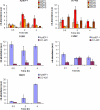Flexibility in anaerobic metabolism as revealed in a mutant of Chlamydomonas reinhardtii lacking hydrogenase activity
- PMID: 19117946
- PMCID: PMC2652310
- DOI: 10.1074/jbc.M803917200
Flexibility in anaerobic metabolism as revealed in a mutant of Chlamydomonas reinhardtii lacking hydrogenase activity
Abstract
The green alga Chlamydomonas reinhardtii has a network of fermentation pathways that become active when cells acclimate to anoxia. Hydrogenase activity is an important component of this metabolism, and we have compared metabolic and regulatory responses that accompany anaerobiosis in wild-type C. reinhardtii cells and a null mutant strain for the HYDEF gene (hydEF-1 mutant), which encodes an [FeFe] hydrogenase maturation protein. This mutant has no hydrogenase activity and exhibits elevated accumulation of succinate and diminished production of CO2 relative to the parental strain during dark, anaerobic metabolism. In the absence of hydrogenase activity, increased succinate accumulation suggests that the cells activate alternative pathways for pyruvate metabolism, which contribute to NAD(P)H reoxidation, and continued glycolysis and fermentation in the absence of O2. Fermentative succinate production potentially proceeds via the formation of malate, and increases in the abundance of mRNAs encoding two malate-forming enzymes, pyruvate carboxylase and malic enzyme, are observed in the mutant relative to the parental strain following transfer of cells from oxic to anoxic conditions. Although C. reinhardtii has a single gene encoding pyruvate carboxylase, it has six genes encoding putative malic enzymes. Only one of the malic enzyme genes, MME4, shows a dramatic increase in expression (mRNA abundance) in the hydEF-1 mutant during anaerobiosis. Furthermore, there are marked increases in transcripts encoding fumarase and fumarate reductase, enzymes putatively required to convert malate to succinate. These results illustrate the marked metabolic flexibility of C. reinhardtii and contribute to the development of an informed model of anaerobic metabolism in this and potentially other algae.
Figures



Similar articles
-
Identification of genes required for hydrogenase activity in Chlamydomonas reinhardtii.Biochem Soc Trans. 2005 Feb;33(Pt 1):102-4. doi: 10.1042/BST0330102. Biochem Soc Trans. 2005. PMID: 15667277
-
Altered fermentative metabolism in Chlamydomonas reinhardtii mutants lacking pyruvate formate lyase and both pyruvate formate lyase and alcohol dehydrogenase.Plant Cell. 2012 Feb;24(2):692-707. doi: 10.1105/tpc.111.093146. Epub 2012 Feb 21. Plant Cell. 2012. PMID: 22353371 Free PMC article.
-
A mutant in the ADH1 gene of Chlamydomonas reinhardtii elicits metabolic restructuring during anaerobiosis.Plant Physiol. 2012 Mar;158(3):1293-305. doi: 10.1104/pp.111.191569. Epub 2012 Jan 23. Plant Physiol. 2012. PMID: 22271746 Free PMC article.
-
Multiple facets of anoxic metabolism and hydrogen production in the unicellular green alga Chlamydomonas reinhardtii.New Phytol. 2011 Apr;190(2):279-88. doi: 10.1111/j.1469-8137.2010.03534.x. New Phytol. 2011. PMID: 21563367 Review.
-
Malic enzymes in cancer: Regulatory mechanisms, functions, and therapeutic implications.Redox Biol. 2024 Sep;75:103273. doi: 10.1016/j.redox.2024.103273. Epub 2024 Jul 19. Redox Biol. 2024. PMID: 39142180 Free PMC article. Review.
Cited by
-
Weak acids produced during anaerobic respiration suppress both photosynthesis and aerobic respiration.Nat Commun. 2023 Jul 14;14(1):4207. doi: 10.1038/s41467-023-39898-0. Nat Commun. 2023. PMID: 37452043 Free PMC article.
-
Identification of the Elusive Pyruvate Reductase of Chlamydomonas reinhardtii Chloroplasts.Plant Cell Physiol. 2016 Jan;57(1):82-94. doi: 10.1093/pcp/pcv167. Epub 2015 Nov 15. Plant Cell Physiol. 2016. PMID: 26574578 Free PMC article.
-
Cyclic electron flow is redox-controlled but independent of state transition.Nat Commun. 2013;4:1954. doi: 10.1038/ncomms2954. Nat Commun. 2013. PMID: 23760547 Free PMC article.
-
Relevance of nutrient media composition for hydrogen production in Chlamydomonas.Photosynth Res. 2015 Sep;125(3):395-406. doi: 10.1007/s11120-015-0152-7. Epub 2015 May 8. Photosynth Res. 2015. PMID: 25952745 Review.
-
Characterization of unusual truncated hemoglobins of Chlamydomonas reinhardtii suggests specialized functions.Planta. 2015 Jul;242(1):167-85. doi: 10.1007/s00425-015-2294-4. Epub 2015 Apr 19. Planta. 2015. PMID: 25893868
References
-
- Merchant, S. S., Prochnik, S. E., Vallon, O., Harris, E. H., Karpowicz, S. J., Witman, G. B., Terry, A., Salamov, A., Fritz-Laylin, L. K., Marechal-Drouard, L., Marshall, W. F., Qu, L. H., Nelson, D. R., Sanderfoot, A. A., Spalding, M. H., Kapitonov, V. V., Ren, Q., Ferris, P., Lindquist, E., Shapiro, H., Lucas, S. M., Grimwood, J., Schmutz, J., Cardol, P., Cerutti, H., Chanfreau, G., Chen, C. L., Cognat, V., Croft, M. T., Dent, R., Dutcher, S., Fernandez, E., Fukuzawa, H., Gonzalez-Ballester, D., Gonzalez-Halphen, D., Hallmann, A., Hanikenne, M., Hippler, M., Inwood, W., Jabbari, K., Kalanon, M., Kuras, R., Lefebvre, P. A., Lemaire, S. D., Lobanov, A. V., Lohr, M., Manuell, A., Meier, I., Mets, L., Mittag, M., Mittelmeier, T., Moroney, J. V., Moseley, J., Napoli, C., Nedelcu, A. M., Niyogi, K., Novoselov, S. V., Paulsen, I. T., Pazour, G., Purton, S., Ral, J. P., Riano-Pachon, D. M., Riekhof, W., Rymarquis, L., Schroda, M., Stern, D., Umen, J., Willows, R., Wilson, N., Zimmer, S. L., Allmer, J., Balk, J., Bisova, K., Chen, C. J., Elias, M., Gendler, K., Hauser, C., Lamb, M. R., Ledford, H., Long, J. C., Minagawa, J., Page, M. D., Pan, J., Pootakham, W., Roje, S., Rose, A., Stahlberg, E., Terauchi, A. M., Yang, P., Ball, S., Bowler, C., Dieckmann, C. L., Gladyshev, V. N., Green, P., Jorgensen, R., Mayfield, S., Mueller-Roeber, B., Rajamani, S., Sayre, R. T., Brokstein, P., Dubchak, I., Goodstein, D., Hornick, L., Huang, Y. W., Jhaveri, J., Luo, Y., Martinez, D., Ngau, W. C., Otillar, B., Poliakov, A., Porter, A., Szajkowski, L., Werner, G., Zhou, K., Grigoriev, I. V., Rokhsar, D. S., and Grossman, A. R. (2007) Science 318 245-250 - PubMed
-
- Grossman, A. R., Croft, M., Gladyshev, V. N., Merchant, S. S., Posewitz, M. C., Prochnik, S., and Spalding, M. H. (2007) Curr. Opin. Plant Biol. 10 190-198 - PubMed
-
- Kosourov, S., Seibert, M., and Ghirardi, M. L. (2003) Plant Cell Physiol. 44 146-155 - PubMed
-
- Ghirardi, M. L., Posewitz, M. C., Maness, P.-C., Dubini, A., Yu, J., and Seibert, M. (2007) Annu. Rev. Plant Biol. 58 71-91 - PubMed
-
- Atteia, A., van Lis, R., Gelius-Dietrich, G., Adrait, A., Garin, J., Joyard, J., Rolland, N., and Martin, W. (2006) J. Biol. Chem. 281 9909-9918 - PubMed
Publication types
MeSH terms
Substances
LinkOut - more resources
Full Text Sources
Molecular Biology Databases

